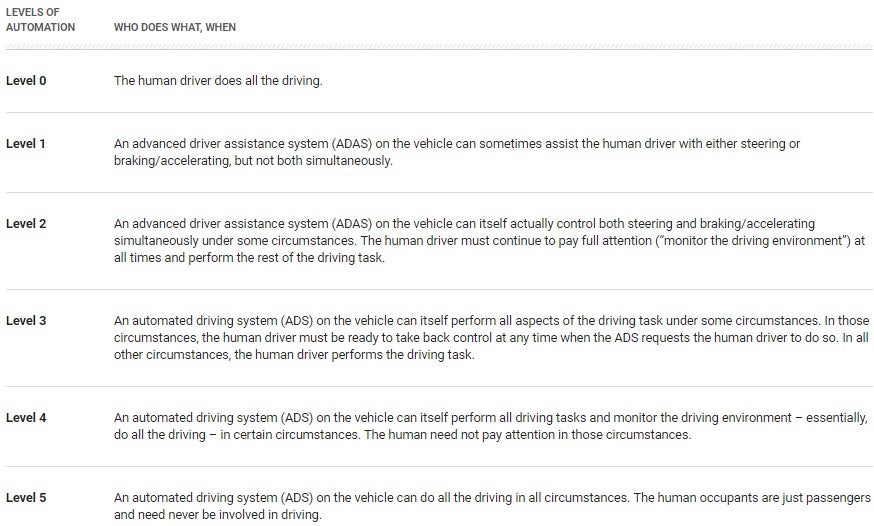A group representing makers of self-driving cars and trucks wants the Biden administration to reconsider its recent order mandating that manufacturers and operators of automated vehicles promptly report data involving certain crashes that occur while the automation technology is engaged.
The Self-Driving Coalition, whose members include truck technology companies Embark, TuSimple and Waymo — all of which are included in the order issued on June 29 by the National Highway Traffic Safety Administration — contends that the order needs to distinguish between vehicles that operate advanced driver assistance systems (ADAS) and those that use automated driving systems (ADS).
The government considers ADAS to be a Level 1 or Level 2 technology in terms of driver engagement, whereas ADS is considered a Level 3, 4 or 5 technology, with a Level 5 system requiring zero driver engagement.
“The Self-Driving Coalition and NHTSA share the same goal: to significantly reduce the number of lives tragically lost each year on U.S. roads,” the coalition stated in response to the order. The group pointed out that having national reporting standards is important for increasing public understanding of autonomous vehicles.
“But there must be a distinction between our members’ autonomous vehicles — which do not require human intervention to operate safely — and driver assistance technology like Tesla’s, which requires an attentive driver,” the coalition stressed. “We have worked with NHTSA in a highly collaborative and transparent way. As we review NHTSA’s new standing general order, the Coalition hopes to restart those constructive conversations so that we can work together to save lives and make our roads safer for everyone.”

Responding to the coalition’s concerns, a NHTSA official cited federal regulations to justify the lack of a reporting distinction for ADAS and ADS technology companies, which it notes in the general order.
Both types of systems are “motor vehicle equipment” subject to the requirements of the federal Safety Act, the order states. “Given the rapid evolution of these technologies and testing of new technologies and features on publicly accessible roads, it is critical for NHTSA to exercise its robust oversight over potential safety defects in vehicles operating with ADS and Level 2 ADAS.”
In addition, according to the order, “the Safety Act is preventive, and the identification of safety defects does not and should not wait for injuries or deaths to occur. The purpose of the Safety Act … is not to protect individuals from the risks associated with defective vehicles only after serious injuries have already occurred; it is to prevent serious injuries stemming from established defects before they occur.”
The official added that the agency has always had regular communication with manufacturers, and vehicle and equipment manufacturers.
“By law, manufacturers of vehicles and equipment have been required to report some crashes quarterly through NHTSA’s Early Warning Reporting Death and Injury Reports,” according to a statement from NHTSA to FreightWaves. “These requirements, however, did not apply to commercial operators of vehicle systems that do not require a human driver and there was no comprehensive mechanism that required the manufacturers or operators of automated driving systems and vehicles with … Level 2 advanced driver assistance systems to regularly report crash data.”
NHTSA’s order requires the 108 companies included in its order to report crashes that occur on public roads based on the following situations:
- Within one day of learning of a crash, companies must report crashes involving a Level 2 ADAS or Levels 3-5 ADS-equipped vehicle that also involve a hospital-treated injury, a fatality, a vehicle tow-away, an airbag deployment or a vulnerable road user such as a pedestrian or bicyclist.
- An updated report is due 10 days after a company learns of the crash. Every month, companies must report all other crashes involving an ADS-equipped vehicle that result in an injury or property damage.
- Reports must be updated monthly with new or additional information.
- Reports must be submitted for any reportable crash about which a company receives notice, beginning 10 days after the company is served with the order.
- Reports must be submitted to NHTSA electronically using a form (sample here) that requires important information regarding the crash. NHTSA will use this information to identify crashes for follow-up.
ADS and ADAS will be under much tighter crash data reporting requirements than the current standard quarterly reporting requirements for NHTSA as well as the Federal Motor Carrier Safety Administration, which also expects crash data involving trucks to be submitted by states on a quarterly basis.
Also of concern is keeping proprietary data confidential for companies looking to gain a foothold in the highly competitive self-driving vehicle sector.
“Autonomous vehicle companies want to do the right thing,” said Ariel Wolf, who leads the Autonomous and Connected Mobility group at the law firm Venable.
“Clients of ours in this space — passenger and trucking companies alike — are comfortable having a dialogue with NHTSA and they understand that data sharing with regulators is important. But suddenly there is this huge new demand for data that’s being sought out by the government that will be treated as publicly disclosable, but there was no industry input on the process or substance of what will be required. That’s a concern for an industry that wants to do the right thing, and wants to ensure that important crash data be put in the hands of the right people.”







